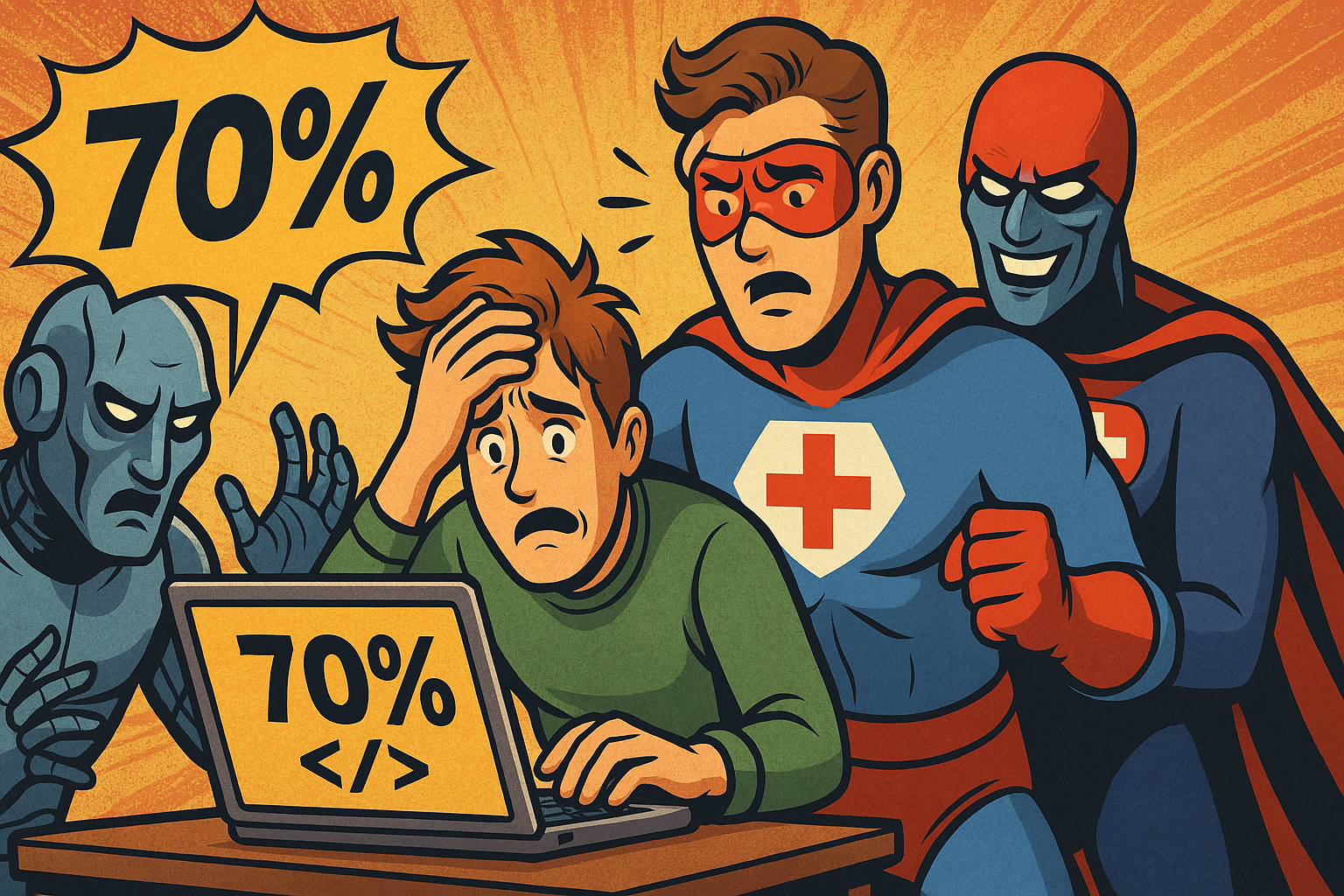AI coding assistants promise a world where development happens at the speed of thought—describe what you want, and watch as functional code materializes before your eyes. But for countless developers and businesses, there's a painful reality lurking behind this promise: the 70% barrier. You race through initial development only to hit an invisible wall, leaving you stranded with almost-working code that seems impossible to finish. This isn't just frustrating—it's a productivity killer that's creating unprecedented technical debt across the industry.
The 70% Problem Explained
In recent months, a phenomenon known as "the 70% problem" has gained recognition among developers using AI tools. The pattern is remarkably consistent: AI tools help users make rapid initial progress—approximately 70% of the way to a working solution—but then users get hopelessly stuck trying to complete the final 30%27.
The Initial Magic
At first, it feels like magic. Describe what you want, and tools like GitHub Copilot or ChatGPT generate a prototype that looks impressively functional and polished. Within minutes, you've assembled a structure that would have taken hours or days to create manually. This initial productivity boost is intoxicating and explains why approximately 70% of developers now use or plan to use AI tools in their development process9.
"The first 70% feels magical," notes AI researcher Arman Eker. "You try to fix a small bug. The AI proposes a solution that seems sensible. That fix causes another problem. You ask the AI to address the new issue. Two more bugs appear"2.
The Two Steps Back Pattern
What follows is what industry experts call the "Two Steps Back Pattern"—a frustrating cycle that emerges once you've reached that 70% completion threshold:
- You identify a problem in the AI-generated code
- You ask the AI to fix it
- The fix works but breaks something else
- You ask the AI to address the new issue
- This creates two more problems
- Repeat indefinitely27
This cycle is especially painful for non-engineers or junior developers because they often lack the mental models to understand what's actually going wrong. When an experienced developer encounters an error, they can infer potential causes based on years of pattern recognition. Without this background, you're essentially playing a frustrating game of whack-a-mole with code you don't fully understand7.
The Hidden Technical Debt Catastrophe
Behind this frustration lies something even more dangerous: massive accumulation of technical debt. Recent studies reveal alarming trends:
Broken Architecture and Duplicated Code
AI doesn't understand your system—it just generates code based on statistical patterns without considering your architecture or existing functionality. A GitClear study found that the adoption of AI coding assistants has led to an 8x increase in duplicated code blocks9. This redundancy means when changes are needed, developers must manually update multiple copies, increasing the risk of bugs and maintenance headaches.
Security Vulnerabilities You Can't See
AI can generate code that works in common cases but completely ignores security flaws and edge cases. Think unvalidated inputs (hello, security vulnerabilities) or poor resource management (like database connections left open)4. One analysis revealed that approximately 40% of programs generated with GitHub Copilot contain vulnerabilities5, creating serious security risks that may not be apparent until it's too late.
The Productivity Illusion
What appears to be increased productivity often becomes a mirage. A study showed that developers can code up to 55% faster with AI—but that can also mean 55% more poorly structured code that needs to be maintained later9. Code churn—the amount of code that gets added, then quickly modified or removed—has doubled between 2021 and 2024 due to AI-generated suggestions9.
The Emotional Toll: Developers Left Behind
The most immediate impact of the 70% problem is psychological. When AI tools generate impressive-looking code so quickly, hitting a wall in the final stages feels especially disheartening. Developers report:
- Increased frustration and stress when AI solutions create cascading problems
- A sense of inadequacy when they can't resolve seemingly simple issues
- Time pressure as initial rapid progress creates unrealistic expectations about completion times
- Loss of confidence in both the AI tools and their own abilities27
This psychological impact explains why many developers describe feeling "abandoned" by the very tools that promised to make their work easier and more efficient.
How Vibe Code Rescue Bridges the 70% Gap
This is precisely where Vibe Code Rescue comes in. We specialize in transforming that frustrating 70% of AI-generated code into production-ready solutions that perform, scale, and maintain easily. Here's how we approach the challenge:
1. Comprehensive Code Reviews and Security Audits
Our senior developers perform thorough code reviews that identify security vulnerabilities, architectural flaws, and performance bottlenecks in your AI-generated code. We don't just fix surface-level bugs—we address the fundamental issues that keep your application from reaching the finish line.
2. Architectural Refinement
We restructure your codebase according to industry best practices, eliminating duplicated code and ensuring your application follows DRY (Don't Repeat Yourself) principles. This dramatically reduces maintenance costs and makes future development significantly easier.
3. Real-World Performance Optimization
AI-generated code often ignores critical performance considerations. Our team applies decades of combined experience to optimize your application for speed, resource efficiency, and scalability—ensuring it doesn't just work in demos but performs flawlessly under real-world conditions.
4. Production-Ready Transformation
We bridge the gap between "almost working" and "ready for production" by implementing proper error handling, logging, testing, and deployment configurations. These critical elements are frequently overlooked by AI assistants but are essential for any application in production.
Breaking Free from the 70% Trap
The 70% problem doesn't mean you should abandon AI tools—it means you need a strategic approach to using them effectively. Here are some recommendations for leveraging AI while avoiding its pitfalls:
Use AI for What It Does Best
AI excels at generating boilerplate code, suggesting approaches, and helping with repetitive tasks. Use it for these purposes but maintain healthy skepticism about complex implementations.
Implement Thorough Code Reviews
Never accept AI-generated code without careful review. Establish processes that ensure every AI contribution is examined for security issues, performance problems, and architectural consistency.
Focus on Building Understanding
Rather than treating AI as a magical solution, use it as a learning tool. Take time to understand the code it generates and build your mental models rather than blindly implementing suggestions.
Partner with Experts When Needed
When you've hit the 70% wall and can't seem to move forward, working with experienced developers can save weeks of frustration and produce better results than continuing to struggle alone.
Don't Let the 70% Nightmare Hold You Back
If you're currently stuck in the frustrating cycle of almost-working AI-generated code, you're not alone. The 70% problem is a recognized industry challenge that affects developers at all skill levels. But with the right approach and support, you can transform that promising but incomplete codebase into a polished, production-ready application that delivers real value.
At Vibe Code Rescue, we've helped numerous companies overcome this exact challenge, turning AI-generated code into robust, scalable applications built for the long term. Schedule a consultation with our experts today, and let's discuss how we can help you bridge the crucial final 30% of your development journey.
Remember: AI is a powerful tool, but the final steps toward production-ready code still require human expertise, experience, and attention to detail. Don't let the 70% nightmare leave you frustrated and abandoned—reach out today for the rescue your code deserves.




